The Betic Ophiolites and the Mesozoic Evolution of the Western Tethys
Abstract
:1. Introduction
2. Geographical and Geological Setting of the Betic Ophiolites
3. Petrology and Metamorphic Evolution
- (a)
- Ocean floor metamorphism and metasomatism induced serpentinization stage of the ultramafic rocks and rodingitization of the intruded doleritic dykes (Puga et al. [10,17,19]; Alt et al. [22]). It also produced paragenesis of very high gradient in amphibolite facies, characteristic of ocean floor metamorphism, preserved in some gabbros and basalts [11,14,21,40]. The P-T conditions of this oceanic metamorphism and metasomatism, represented in Figure 4, mainly correspond to the range of P-T calculated for the brown amphiboles of the Cóbdar metabasites, shown in Photo 3c-3, by Puga et al. [14].
- (b)
- Orogenic metamorphism, begining with subduction of the ocean floor during an initial metamorphic event known as Eo-Alpine, which attained eclogite facies conditions. This was followed by exhumation of part of this subducted ocean floor onto the continental margin, during and after which the Meso-Alpine and Neo-Alpine metamorphic events of Oligocene and Miocene ages took place [10,11,13,20]. The successive parageneses of eclogite, Ab-Ep amphibolite and greenschist facies developed during these three metamorphic events, variously overprinting the pristine igneous parageneses and textures [11,13,14,15,19,40].
4. Geochemical Characteristics and Tectonic Setting of the BOA Magmas
5. Radiometric Dating of the BOA
6. Comparison of the Betic Ophiolites Radiometric Dating with Those of Alpine-Apenninic Ophiolites
7. Mesozoic Paleogeographic Reconstruction of the Betic Tethys
8. Cretaceous Paleogeographic Reconstruction of the Betic Tethys and Eo-Alpine Metamorphic Evolution
9. Neogene Geodynamic Evolution of the Mesomediterranean Terrane
10. Genetic and Evolutionary History of the Betic Ophiolites and the Nevado-Filábride Complexes
11. Discussion
12. Conclusions
Acknowledgments
Author Contributions
Conflicts of Interest
References
- Puga, E. Sur l’existence dans le complexe de la Sierra Nevada (Cordillère Bétique, Espagne du sud) d’éclogites et sur leur origine probable à partir d’une croûte océanique mésozoique. C. R. Acad. Sci. 1977, 285, 1379–1382. (In French) [Google Scholar]
- Puga, E.; Díaz de Federico, A. Metamorfismo polifásico y deformaciones alpinas en el Complejo de Sierra Nevada (Cordillera Bética). Implicaciones geodinámicas. In Reunión sobre la Geodinámica de las Cordilleras Béticas y el Mar de Alborán; Universidad de Granada, Secretariado de Publicaciones: Granada, Spain, 1978; pp. 79–111. (In Spanish) [Google Scholar]
- Puga, E. The BeticOphiolitic Association (Southeastern Spain). Ofioliti 1990, 15-1, 97–117. [Google Scholar]
- Bodinier, J.L.; Morten, L.; Puga, E.; Diaz de Federico, A. Geochemistry of metabasites from the Nevado-Filábride complex, Betic Cordilleras, Spain: Relics of a dismembered ophiolitic sequence. Lithos 1987, 20, 235–245. [Google Scholar] [CrossRef]
- Morten, L.; Bargossi, G.M.; Martinez Martinez, J.M.; Puga, E.; Diaz de Federico, A. Metagabbro and associated eclogites in the Lubrín area, Nevado-Filábride Complex, Spain. J. Metamorph. Geol. 1987, 5, 155–174. [Google Scholar] [CrossRef]
- Puga, E.; Díaz de Federico, A.; Fediukova, E.; Bondi, M.; Morten, L. The petrology, geochemistry and metamorphic evolution of the ophiolitic eclogites and related rocks from the Sierra Nevada (Betic Cordilleras, Southeastern Spain). Schweizerische Mineralogische und Petrographische Mitteilungen 1989, 69, 435–455. [Google Scholar]
- Puga, E.; Díaz de Federico, A.; Bargossi, G.M.; Morten, L. The Nevado-Filábride metaophiolitic association in the Cóbdar region (Betic Cordillera, SE Spain): Preservation of pillow structures and development of coronitic eclogites. Geodin. Acta 1989, 3, 17–36. [Google Scholar] [CrossRef]
- Guerrera, F.; Martin-Algarra, A.; Perrone, V. Late Oligocene–Miocene syn-/-late-orogenic successions in Western and Central Mediterranean Chains from the Betic Cordillera to the Southern Apennines. Terra Nova 1993, 5, 525–544. [Google Scholar] [CrossRef]
- Puga, E.; Díaz De Federico, A.; Demant, A. The eclogitized pillows of the Betic Ophiolitic Association: Relics of the Tethys ocean floor incorporated to the Alpine Chain after subduction. Terra Nova 1995, 7, 32–43. [Google Scholar] [CrossRef]
- Puga, E.; Nieto, J.M.; Díaz De Federico, A.; Bodinier, J.L.; Morten, L. Petrology and metamorphic evolution of ultramafic rocks and dolerite dykes of the BeticOphiolitic Association (Mulhacén Complex, SE Spain): Evidence of eo-Alpine subduction following an ocean-floor metasomatic process. Lithos 1999, 49, 107–140. [Google Scholar] [CrossRef]
- Puga, E.; Nieto, J.M.; Díaz de Federico, A. Contrasting P-T paths in eclogites of the Betic Ophiolitic Association (Mulhacén Complex, SE Spain). Can. Mineral. 2000, 38, 1137–1161. [Google Scholar] [CrossRef]
- Gómez-Pugnaire, M.T.; Ulmer, P.; López-Sánchez-Vizcaíno, V. Petrogenesis of the mafic igneous rocks of the Betic Cordilleras: A field, petrological and geochemical study. Contrib. Mineral. Petrol. 2000, 139, 436–457. [Google Scholar] [CrossRef]
- Puga, E.; Díaz de Federico, A.; Nieto, J.M. Tectono-stratigraphic subdivison and petrological characterisation of the deepest complexes of the Betic Zone: A Review. Geodin. Acta 2002, 15, 23–43. [Google Scholar] [CrossRef]
- Puga, E.; Ruiz Cruz, M.D.; Díaz de Federico, A. Polymetamorphic amphibole veins in metabasalts from the Betic Ophiolitic Association (SE Spain): Relics of ocean-floor metamorphism preserved throughout the Alpine Orogeny. Can. Mineral. 2002, 40, 67–83. [Google Scholar] [CrossRef]
- Puga, E.; Fanning, C.M.; Nieto, J.M.; Díaz de Federico, A. New recrystallisation textures in zircons generated by ocean-floor and eclogitefacies metamorphism: A cathodoluminescence and U–Pb SHRIMP study with constraints from REE elements. Can. Mineral. 2005, 42, 1349–1368. [Google Scholar]
- Puga, E.; Díaz de Federico, A.; Nieto, J.M.; Díaz Puga, M.A. Petrología, georrecursos y evolución geodinámica del Espacio Natural de Sierra Nevada. Estud. Geol. 2007, 63/2, 19–40. (In Spanish) [Google Scholar]
- Puga, E.; Díaz de Federico, A.; Nieto, J.M.; Díaz Puga, M.A. The Betic Ophiolitic Association: A very significant geological heritage in urgent need of preservation. Geoheritage 2009, 1, 11–31. [Google Scholar] [CrossRef]
- Puga, E.; Rodríguez Martínez-Conde, J.A.; Díaz de Federico, A.; Manteca Martínez, J.I.; Díaz Puga, M.A. Caracterización geoquímica y ambiente geodinámico de génesis de las metabasitas de la Sierra del Algarrobo (Cordillera Bética oriental). Geogaceta 2009, 46, 11–14. (In Spanish) [Google Scholar]
- Puga, E.; Fanning, M.; Díaz de Federico, A.; Nieto, J.M.; Beccaluva, L.; Bianchini, G.; Díaz Puga, M.A. Petrology, geochemistry and U–Pb geochronology of the Betic Ophiolites: Inferences for Pangaea break-up and birth of the westernmost Tethys Ocean. Lithos 2011, 124, 255–272. [Google Scholar] [CrossRef]
- Ruiz Cruz, M.D.; Puga, E.; Nieto, J.M. Silicate and ore exsolutions in pseudo-spinifex olivine of the metaultramafic rocks from the Betic Ophiolitic Association: A TEM study. Am. Mineral. 1999, 11–12, 1915–1924. [Google Scholar] [CrossRef]
- Ruiz Cruz, M.D.; Puga, E.; Díaz de Federico, A. Exsolution microstructures in amphiboles from metabasalts of the Betic ophiolitic association (SE Spain). Eur. J. Mineral. 2007, 19, 547–556. [Google Scholar] [CrossRef]
- Alt, J.C.; Garrido, C.J.; Shanks III, W.C.; Turchyn, A.; Padrón-Navarta, J.A.; López Sánchez-Vizcaíno, V.; Gómez-Pugnaire, M.T.; Marchesi, C. Recycling of water, carbon and sulfur during subduction of serpentinites: A stable isotope study of Cerro del Almirez, Spain. Earth Planet. Sci. Lett. 2012, 327–328, 50–60. [Google Scholar] [CrossRef]
- Aerden, D.G.A.M.; Bell, T.H.; Puga, E.; Sayab, M.; Lozano, J.A.; Díaz de Federico, A. Multi-stage mountain building vs. relative plate motions in the Betic Cordillera deduced from integrated microstructural and petrological analysis of porphyroblast inclusion trails. Tectonophysics 2013, 587, 188–206. [Google Scholar] [CrossRef]
- Beccaluva, L.; Macciotta, G.; Piccardo, G.B.; Zeda, O. Petrology of lherzolitic rocks from the Northern Apennine ophiolites. Lithos 1984, 17, 299–316. [Google Scholar] [CrossRef]
- Beccaluva, L.; Coltorti, M.; Saccani, E.; Siena, F.; Zeda, O. Triassic magmatism and Jurassic Ophiolites at the margins of the Adria Plate. In Crop Project—Deep Seismic Exploration of the Central Mediterranean and Italy; Finetti, I., Ed.; Elsevier Science: Amsterdam, The Netherlands, 2005; pp. 607–621. [Google Scholar]
- Marroni, M.; Molli, G.; Montanini, A.; Tribuzio, R. The association of continental crust rocks with ophiolites in the Northern Apennines (Italy): Implications for the continent-ocean transition in the Western Tethys. Tectonophysics 1998, 292, 43–66. [Google Scholar] [CrossRef]
- Montanini, A.; Tribuzio, R.; Vernia, L. Petrogenesis of basalts and gabbros from an ancient continent–ocean transition (External Liguride ophiolites, Northern Italy). Lithos 2008, 101, 453–479. [Google Scholar] [CrossRef]
- Manatschal, G.; Müntener, O. A type sequence across an ancient magma-poor ocean–continent transition: The example of the western Alpine Tethys ophiolites. Tectonophysics 2009, 473, 4–19. [Google Scholar] [CrossRef]
- Piccardo, G.B.; Guarnieri, L. Alpine peridotites from the Ligurian Tethys: An updated critical review. Int. Geol. Rev. 2010, 52, 1138–1159. [Google Scholar] [CrossRef]
- Saccani, E.; Dilek, Y.; Marroni, M.; Pandolfi, L. Continental margin ophiolites of Neotethys: Remnants of Ancient Ocean-Continent Transition Zone (OCTZ) lithosphere and their geochemistry, mantle sources and melt evolution patterns. Episodes 2015, 38, 230–249. [Google Scholar]
- Lagabrielle, Y.; Brovarone, A.V.; Ildefonse, B. Fossil oceanic core complexes recognized in the blueshist metaophiolites of western Alps and Corsica. Earth Sci. Rev. 2015, 141, 1–26. [Google Scholar] [CrossRef]
- Dick, H.J.B.; Lin, J.; Schouten, H. An ultraslow-spreading class of ocean ridge. Nature 2003, 426, 405–412. [Google Scholar] [CrossRef] [PubMed]
- Lagabrielle, Y. Mantle exhumation and lithospheric spreading: An historical perspective from investigations in the Oceans and in the Alps-Apennines ophiolites. Ital. J. Geosci. (Boll. Soc. Geol. Ital.) 2009, 128, 279–293. [Google Scholar]
- Gale, A.; Laubier, M.; Escrig, S.; Langmuir, C.H. Constraints on melting processes and plume-ridge interaction from comprehensive study of the FAMOUS and North Famous segments, Mid-Atlantic Ridge. Earth Planet. Sci. Lett. 2013, 365, 209–220. [Google Scholar] [CrossRef]
- Herbrich, A.; Hauff, F.; Hoernle, K.; Werner, R.; Garbe-Schönberg, D.; White, S. A 1.5 Ma record of plume-ridge interaction at the Western Galápagos Spreading Center (91°40′–92°00′ W). Geochimica et Cosmochimica Acta 2015, 185, 141–159. [Google Scholar] [CrossRef]
- Regelous, M.; Weinzierl, C.G.; Haase, K.M. Controls on melting at spreading ridges from correlated abyssal peridotite – mid-ocean ridge basalt compositions. Earth Planet. Sci. Lett. 2016, 449, 1–11. [Google Scholar] [CrossRef]
- Puga, E.; Díaz de Federico, A.; Nieto, J.M.; Díaz Puga, M.A.; Rodríguez Martínez Conde, J.A.; Manteca Martínez, J.I. Argumentos petrológicos y geoquímicas para la subdivisión del Complejo Nevado-Filábride en los Complejos del Veleta y del Mulhacén. VI Congreso Geológico de España, Zaragoza (España). Geo-Temas 2004, 6, 101–104. (In Spanish) [Google Scholar]
- Puga, E.; Díaz de Federico, A.; Manteca Martínez, J.I.; Rodríguez Martínez Conde, J.A.; Díaz Puga, M.A. The Canteras-Galifa Neogene conglomerates: Evidence for an ophiolitic association submerged in the Mediterranean Sea at the Eastern end of the Betic Chain. Ofioliti 2004, 29, 213–230. [Google Scholar]
- Tendero, J.A.; Martin-Algarra, A.; Puga, E.; Díaz De Federico, A. Lithostratigraphie des métasédiments de l’association ophiolitique Nevado-Filábride (SE Espagne) et mise en evidence d’objets ankéritiques évoquant des foraminiféres planctoniques du Crétacé: Conséquences paléogéographiques. C. R. Acad. Sci. 1993, 316, 1115–1122. (In French) [Google Scholar]
- Puga, E.; Ruiz Cruz, M.D.; Díaz De Federico, A. Magnetite-silicate inclusions in olivine of ophiolitic meta-gabbros from the Mulhacén Complex (Betic Cordillera, SE Spain). Can. Mineral. 1999, 37, 1191–1209. [Google Scholar]
- Nieto, J.M. Petrología y Geoquímica de los Ortogneises del Complejo del Mulhacén, Cordilleras Béticas. Ph.D. Thesis, Universidad de Granada, Granada, Spain, 1996; p. 211. (In Spanish). [Google Scholar]
- Nieto, J.M.; Puga, E.; Díaz de Federico, A. Late Variscan pyroclastic rocks from the Mulhacén Complex (Betic Cordillera, Spain), 217-24. In Volcaniclastic Rocks, from Magmas to Sediments; Leyrit, H., Montenat, C., Eds.; Gordon and Breach Science Publishers: Philadelphia, PA, USA, 2000; p. 265. [Google Scholar]
- Lemoine, M.; Marthaler, M.; Carón, M.; Sartori, M.; Amaudric Du Chaffaut, S.; Dumont, T.; Escher, A.; Masson, H.; Polino, R.; Tricart, P. Découverte de foraminiféres planctoniques du Crétacé supérieur dans les schistes lustres du Queyras (Alpes occidentales), Conséquences paléogéographiques et tectoniques. C. R. Acad. Sci. 1984, 299, 727–732. (In French) [Google Scholar]
- Lagabrielle, Y.; Polino, R.; Auzende, J.M.; Blanchet, R.; Caby, R.; Fudral, S.; Lemoine, M.; Mevel, C.; Ohnenstetter, M.; Robert, D.; et al. Les témoins d’une tectonique intraocéanique dans le domaine téthysien: Analyse des rapports entre les ophiolites et leurs couvertures métasédimentaires dans la Zone Piémontaise des Alpes franco-italiennes. Ofioliti 1984, 9, 67–88. (In French) [Google Scholar]
- Shervais, J.W. Ti–V plots and the petrogenesis of modern ophiolitic lavas. Earth Planet. Sci. Lett. 1982, 59, 101–118. [Google Scholar] [CrossRef]
- Pearce, J.A. Trace element characteristics of lavas from destructive plate boundaries. In Andesites; Thorpe, R.S., Ed.; John Wiley & Sons: Hoboken NJ, USA; pp. 525–548.
- Boynton, W.V. Cosmochemistry of the rare earth elements: Meteorite studies. In Rare Earth Element; Henderson, P., Ed.; Geochemistry Elsevier: Amsterdam, The Netherlands, 1984; pp. 63–114. [Google Scholar]
- Snow, J.E.; Hart, S.R.; Dick, H.J.B. Nd and Sr isotope evidence linking mid-oceanridge basalts and abyssal peridotites. Nature 1994, 371, 57–60. [Google Scholar] [CrossRef]
- Hoffman, A.V. Mantle geochemistry: The message from oceanic volcanism. Nature 1997, 385, 219–229. [Google Scholar] [CrossRef]
- Marzoli, A.; Renne, P.R.; Piccirillo, E.M.; Ernesto, M.; Bellieni, G.; De Min, A. Extensive 200-Million-year-old continental flood basalts of the Central Atlantic Magmatic Province. Science 1999, 284, 616–618. [Google Scholar] [CrossRef] [PubMed]
- Saccani, E.; Photiades, A.; Beccaluva, L. Petrogenesis and tectonic significance of Jurassic IAT magma types in the Hellenide ophiolites as deduced from the Rhodiani ophiolites (Pelagonian zone, Greece). Lithos 2008, 104, 71–84. [Google Scholar] [CrossRef]
- Saccani, E.; Beccaluva, L.; Photiades, A.; Zeda, O. Petrogenesis and tectono-magmatic significance of basalts and mantle peridotites from the Albanian–Greek ophiolites and sub-ophiolitic mélanges. New constraints for the Triassic–Jurassic evolution of the Neo-Tethys in the Dinaride sector. Lithos 2011, 124, 227–242. [Google Scholar] [CrossRef]
- Sun, S.S.; McDonough, W.F. Chemical and isotopic systematic of oceanic basalts; implications for mantle composition and processes. In Magmatism in the Oceanic Basins (Special Publication Geological Society of London); Saunders, A.D., Norry, M.J., Eds.; Geological Society: London, UK, 1989; Volume 42, pp. 313–345. [Google Scholar]
- Pearce, J.A. Inmobile element fingerprinting of Ophiolites. Elements 2014, 10, 101–108. [Google Scholar] [CrossRef]
- Piccardo, G.B. The Jurassic Ligurian Tethys, a fossil ultraslow-spreading ocean: The mantle perspective. Geol. Soc. Lond. Spec. Publ. 2008, 293, 11–34. [Google Scholar] [CrossRef]
- Michael, P.J.; Langmuir, C.H.; Dick, H.J.B.; Snow, J.E. Magmatic and amagmatic seafloor generation at the ultraslow-spreading Gakkel ridge, Arctic Ocean. Nature 2003, 423, 956–961. [Google Scholar] [CrossRef] [PubMed]
- Jones, C.E.; Jenkyns, H.C.; Coe, A.L.; Hesselbo, S.P. Strontium isotopic variations in Jurassic and Cretaceous seawater. Geochim. Cosmochim. Acta 1994, 58, 3061–3074. [Google Scholar] [CrossRef]
- Puga, E. A reappraisal of the Betic Ophiolitic Association: The westernmost relic of the Alpine Tethys Ocean). In Deep Seismic Exploration of the Central Mediterranean and Italy; Finetti, I.R., Ed.; CROP 1 Volume; Elsevier: Amsterdam, The Netherlands, 2005; pp. 665–704. [Google Scholar]
- Handy, M.R.; Schmid, S.M.; Bousquet, R.; Kissling, E.; Bernoulli, D. Reconciling plate-tectonic reconstructions of Alpine Tethys with the geological–geophysical record of spreading and subduction in the Alps. Earth Sci. Rev. 2010, 102, 121–158. [Google Scholar] [CrossRef]
- Puga, E.; Díaz de Federico, A.; Bodinier, J.L.; Monié, P.; Morten, L. The Betic Ophiolitic eclogites (Nevado-Filábride Complex, SE Spain). In Proceedings of the Terra Nova Abstr Second Eclogite Field Symposium, Granada, Spain, 4–10 September 1991; Supplement 6, pp. 9–10. [Google Scholar]
- Portugal Ferreira, M.; Ferreira, J.D.; Puga, E.; Díaz de Federico, A. Geochronological contribution to the petrogenetic picture of the Betic Chain (SE Spain). II Congr. Geol. Esp. Com. 1988, 2, 55–58. [Google Scholar]
- Monié, P.; Galindo-Zaldivar, J.; Gonzalez Lodeiro, F.; Goffe, B.; Jabaloy, A. 40Ar/39Ar geochronology of Alpine tectonism in the Betic Cordilleras (southern Spain). J. Geol. Soc. 1991, 148, 289–297. [Google Scholar] [CrossRef]
- López Sánchez-Vizcaíno, V.; Rubatto, D.; Gómez Pugnaire, M.T.; Trommsdorff, V.; Müntener, O. Middle Miocene high-pressure metamorphism and fast exhumation of the Nevado–Filábride Complex, SE Spain. Terra Nova 2001, 13, 327–332. [Google Scholar] [CrossRef]
- De Jong, K. Very fast exhumation of high-pressure metamorphic rocks with excess 40Ar and inherited 87Sr, Betic Cordilleras, southern Spain. Lithos 2003, 70, 91–110. [Google Scholar] [CrossRef]
- Hebeda, E.H.; Boelrijk, N.A.I.M.; Priem, H.N.A.; Verdurmen, E.A.T.; Verschure, R.H.; Simon, O.J. Excess radiogenic Ar and undisturbed Rb–Sr systems in basic intrusives subjected to Alpine metamorphism in southeastern Spain. Earth Planet. Sci. Lett. 1980, 47, 81–90. [Google Scholar] [CrossRef]
- Bortolotti, V.; Principi, G. Tethyan ophiolites and Pangaea breakup. Isl. Arcs 2005, 14, 442–470. [Google Scholar] [CrossRef]
- Borsi, L.; Schärer, U.; Gaggero, L.; Crispini, L. Age, origin and geodynamic significance of plagiogranites in lherzolites and gabbros of the Piedmont–Ligurian ocean basin. Earth Planet. Sci. Lett. 1996, 140, 227–241. [Google Scholar] [CrossRef]
- Costa, S.; Caby, R. Evolution of the Ligurian Tethys in the Western Alps: Sm/Nd and U/Pb geochronology and rare-earth element geochemistry of the Montgenève ophiolite (France). Chem. Geol. 2001, 175, 449–466. [Google Scholar] [CrossRef]
- Rubatto, D.; Scambelluri, M. U–Pb dating of magmatic zircon and metamorphic baddeleyite in the Ligurian eclogites (Voltri Massif, Western Alps). Contrib. Mineral. Petrol. 2003, 146, 341–355. [Google Scholar] [CrossRef]
- Kaczmarek, M.A.; Müntener, O.; Rubatto, D. Trace element chemistry and U–Pb dating of zircons oceanic gabbros and their relationship with whole rock composition (Lanzo, Italian Alps). Contrib. Mineral. Petrol. 2008, 155, 295–312. [Google Scholar] [CrossRef]
- Bill, M.; Bussy, F.; Cosca, M.; Masson, H.; Hunziker, J. High-precision U–Pb and 40Ar/39Ar dating of an Alpine ophiolite (Gets nappe, French Alps. Eclogae Geol. Helv. 1997, 90, 43–54. [Google Scholar]
- Tribuzio, R.; Thirlwall, M.F.; Vannucci, R. Origin of the Gabbro–Peridotite Association from the Northern Apennine Ophiolites (Italy). J. Petrol. 2004, 45, 1109–1124. [Google Scholar] [CrossRef]
- Rampone, E.; Borghini, G.; Romairone, A.; Abouchami, W.; Class, C.; Goldstein, S.L. Sm–Nd geochronology of the Erro-Tobbio gabbros (Ligurian Alps, Italy): Insights into the evolution of the Alpine Tethys. Lithos 2014, 205, 236–246. [Google Scholar] [CrossRef]
- Schettino, A.; Turco, E. Breakup of Pangaea and Plate Kinematics of the central Atlantic and Atlas region. Geophys. J. Inter. 2009, 178, 1078–1097. [Google Scholar] [CrossRef]
- Tubía, J.M.; Cuevas, J.; Esteban, J.J.; Ibarguchi, G. Remnants of a Mesozoic rift in subducted terrane of the Alpujarrride Complex (Betic Cordilleras, Southern Spain). J. Geol. 2009, 117, 71–87. [Google Scholar] [CrossRef]
- Sánchez-Rodríguez, L.; Gebauer, D. Mesozoic formation of pyroxenites and gabbros in the Ronda area (southern Spain), followed by Early Miocene subduction metamorphism and emplacement into the middle crust: U–Pb sensitive high resolution ion microprobe dating of zircon. Tectonophysics 2000, 316, 19–44. [Google Scholar] [CrossRef]
- Principi, G.; Bortolotti, V.; Chiari, M.; Cortesogno, L.; Gaggero, L.; Marcucci, M.; Saccani, E.; Treves, B. The pre-orogenic volcano-sedimentary covers of the Western Tethys oceanic basin: A review. Ofioliti 2004, 29, 177–211. [Google Scholar]
- Puga, E. Enclaves de micaschistes à silicates d’alumine dans les roches volcaniques basiques mèsozoiques de la Cordillère Subbètique: Premiers tèmoins d´un socle, non affleurant, dans les Zones Betiques Externes (Spagne du Sud). C. R. Acad. Sci. 1987, 305, 1503–1506. (In French) [Google Scholar]
- Puga, E.; Portugal Ferreira, M. The recrystallization and partial melting of xenoliths of pelitic rocks and their bearing on the contaminated basalts (Subbetic Zone, Spain). In Magma-Crust Interactions and Evolution; Bonin, B., Didier, J., Le Fort, P., Propach, G., Puga, E., Vistelius, A.B., Eds.; Theophrastus Publications: Athens, Greece, 1989; pp. 115–159. [Google Scholar]
- Puga, E.; Portugal, M.; Díaz De Federico, A.; Bargossi, G.M.; Morten, L. The evolution of the magmatism in the external zones of the Betic Cordilleras during the Mesozoic. Geodin. Acta 1989, 3, 253–266. [Google Scholar] [CrossRef]
- Puga, E.; Van de Fliert, J.R.; Torres Roldan, R.L.; Sanz de Galdeano, C. Attempts of whole-rock K/Ar dating of Mesozoic volcanic and hypabissal igneous rocks from the Central Subbetic (Southern Spain): A case of differential Argon loss related to very low-grade metamorphism. Estud. Geol. 1988, 44, 47–59. [Google Scholar] [CrossRef]
- Puga, E.; Morata, D.; Díaz de Federico, A. Magmatísmo Mesozoico y metamorfismo de muy bajo grado de las Zonas Externas Béticas. In Geología de España; Vera, J.A., Ed.; Sociedad Geográfica de España, Instituto Geológico y Minero de España: Madrid, Spain, 2004; pp. 386–387. (In Spanish) [Google Scholar]
- Portugal-Ferreira, M.; Morata, D.; Puga, E.; Demant, A.; Aguirre, L. Evolución geoquímica y temporal del magmatismo básico Mesozoico en las Zonas Externas de las Cordilleras Béticas. Estud. Geol. 1995, 51, 109–118. (In Spanish) [Google Scholar] [CrossRef]
- Morten, L.; Puga, E. Augite to chloromelanite transformation in ophites from the Subbetic Zone, Betic Cordilleras, Spain. Periodico di Mineralogia 1983, 52, 355–367. [Google Scholar]
- Puga, E.; Morten, L.; Bondi, M.; Bargossi, J.M.; Ruiz Cruz, M.D.; Diaz de Federico, A. Metamorphosed “Ophites” from Archidona Region, Subbetic Zone (Spain). Estud. Geol. 1983, 39, 307–317. [Google Scholar]
- Puga, E.; Beccaluva, L.; Bianchini, G.; Díaz De Federico, A.; Díaz Puga, M.A.; Alvarez-Valero, A.; Galindo-Zaldívar, J.; Wijbrans, J.R. First evidence of lamprophyric magmatism within the Subbetic Zone (Southern Spain). Geol. Acta 2010, 8, 111–130. [Google Scholar]
- Aguirre, L.; Morata, D.; Puga, E.; Baronet, A.; Beiersdorfer, R.E. Chemistry and crystal characteristics of pumpellyite in a metadolerite from the Archidona region, Subbetic Cordillera, Spain. Geol. Soc. Am. 1995, 296, 171–181. [Google Scholar]
- Bouillin, J.P.; Durand-Delgá, M.; Olivier, P. Betic-Rifain and Tyrrenian Arcs: Distinctive features, genesis and development stages. In The Origin of Arcs; Wezel, F.C., Ed.; Elsevier: Amsterdam, The Netherlands, 1986; pp. 281–304. [Google Scholar]
- Chalouan, A.; Michard, A. The Alpine Rif Belt (Morocco): A Case of Mountain Building in a Subduction-Subduction-Transform Fault Triple Junction. Pure Appl. Geophys. 2004, 161, 489–519. [Google Scholar] [CrossRef]
- Lonergan, L.; White, N. Origin of the Betic-Rif mountain belt. Tectonics 1997, 16, 504–522. [Google Scholar] [CrossRef]
- Rosebaum, G.; Lister, G.S. Reconstruction of the evolution of the Alpine-Himalayan Orogen. J. Virtual Explor. 2002, 8, 107–130. [Google Scholar]
- Lustrino, M.; Duggen, S.; Rosenberg, C.L. The Central-Western Mediterranean: Anomalous igneous activity in an anomalous collisional tectonic setting. Earth-Sci. Rev. 2011, 104, 1–40. [Google Scholar] [CrossRef]
- Martín-Martín, M.; Sanz de Galdeano, C.; García-Tortosa, F.C.; Martín-Rojas, I. Tectonic units from the Sierra Espuña—Mula area (SE Spain): Implication on the Triassic paleogeography and the geodynamic evolution for the Betic-Rif Internal Zone. Geodin. Acta 2006, 19, 1–15. [Google Scholar] [CrossRef]
- Perez-Lopez, A.; Perez Valera, F. Paleogeography, facies and nomenclature of the Trias units in the different domains of the Betic Cordillera (S Spain). Palaegeogr. Palaeoclimatol. Palaeoecol. 2007, 254, 606–626. [Google Scholar] [CrossRef]
- Critelli, S.; Mongelli, G.; Perri, F.; Martin-Algarra, A.; Martin-Martin, M.; Perrone, V.; Dominici, R.; Sonnino, M.; Zaghloul, M.N. Compositional and geochemical signatures for the sedimentary evolution of the Middle Triassic-Lower Jurassic Continental Redbeds from Western-Central Mediterranean Alpine Chains. J. Geol. 2008, 116, 375–386. [Google Scholar] [CrossRef]
- Hanne, D.; White, N.; Lonergan, L. Subsidence analyses from the Betic Cordillera, Southeast Spain. Basin Res. 2003, 15, 1–21. [Google Scholar] [CrossRef]
- Martin-Rojas, I.; Somma, R.; Delgado, F.; Estévez, A.; Iannace, A.; Perrone, V.; Zamparelli, V. Triassic continental rifting of Pangaea: Direct evidence from the Alpujárride carbonates, Betic Cordillera, SE Spain. J. Geol. Soc. 2009, 166, 447–458. [Google Scholar] [CrossRef]
- Somma, R.; Martin-Rojas, I.; Zamparelli, V.; Delgado Salazar, F.; Estévez Rubio, A.; Iannace, A.; Perrone, V. First Record of Tethyan Ladinian involutinid foraminifera-rich beds in the Betic Internal Zone (SE Spain). Geogaceta 2010, 48, 67–70. [Google Scholar]
- Zaghloul, M.N.; Critelli, S.; Perri, F.; Mongelli, G.; Perrone, V.; Sonnino, M.; Tucker, M.; Aiello, M.; Ventimiglia, C. Depositional systems, composition and geochemistry of Triassic rifted-continental margin of the Internal Rif Chain, Morocco. Sedimentology 2010, 57, 312–350. [Google Scholar] [CrossRef]
- Carminati, E.; Lustrino, M.; Doglioni, C. Geodynamic evolution of the central and western Mediterranean: Tectonics vs. igneous petrology constraints. Tectonophysics 2012, 579, 173–192. [Google Scholar] [CrossRef]
- Vergés, J.; Fernàndez, M. Tethys–Atlantic interaction along the Iberia–Africa plate boundary: The Betic–Rif orogenic system. Tectonophysics 2012, 579, 144–172. [Google Scholar] [CrossRef]
- Torres-Roldan, R.L.; Poli, G.; Peccerillo, A. An Early Miocene arc-tholeiitic magmatic dike event from the Alboran Sea—Evidence for precollisional subduction and back-arc crustal extension in the westernmost Mediterranean. Geol. Rundsch. 1986, 75/1, 219–234. [Google Scholar] [CrossRef]
- Doblas, M.; López-Ruiz, J.; Cebriá, J. Cenozoic evolution of the Alboran Domain: A review of the tectonomagmatic models. Geol. Soc. Am. 2007, 418, 303–320. [Google Scholar]
- Manatschal, G.; Lavier, L.; Chenin, P. The role of inheritance in structuring hyperextended rift systems: Some considerations based on observations and numerical modeling. Gondwana Res. 2015, 27, 140–164. [Google Scholar] [CrossRef]
- Gillard, M.; Autin, J.; Manatschal, G. Fault systems at hyper-extended rifted margins and embryonic oceanic crust: Structural style, evolution and relation to magma. Mar. Pet. Geol. 2016, 76, 51–67. [Google Scholar] [CrossRef]
- Grindlay, N.R.; Madsen, J.A.; Rommevaux-Jestin, C.; Sclater, J. A different pattern of ridge segmentation and mantle Bouguer gravity anomalies along the ultra-slow spreading Southwest Indian Ridge (15°30′ E to 25° E). Earth Planet. Sci. Lett. 1998, 161, 243–253. [Google Scholar] [CrossRef]
- Lazar, M.; Ben-Avraham, Z.; Garfunkel, Z. The Red Sea—New Insights from recent geophysical studies and the connection to the Dead Sea fault. J. Afr. Earth Sci. 2012, 68, 96–110. [Google Scholar] [CrossRef]
- Kamesh Raju, K.A.; Samudrala, K.; Drolia, R.K.; Amarnath, D.; Ramachandran, R.; Mudholkar, A. Segmentation and morphology of the Central Indian Ridge between 3° S and 11° S, Indian Ocean. Tectonophysics 2012, 554-557, 114–126. [Google Scholar] [CrossRef]
- Murton, B.J.; Rona, P.A. Carlsberg Ridge and Mid Atlantic Ridge: Comparison of slow spreading centre analogues. Deep Sea Res. Part II 2015, 121, 71–84. [Google Scholar] [CrossRef]
- Mercier de Lépinay, M.; Loncke, L.; Basile, C.; Roest, W.R.; Patriat, M.; Maillard, A.; De Clarens, P. Transform continental margins—Part 2: A worldwide review. Tectonophysics 2016, 693, 96–115. [Google Scholar] [CrossRef]
- Manatschal, G.; Sauter, D.; Karpoff, A.M.; Masini, E.; Mohn, G.; Lagabrielle, Y. The Chenaillet Ophiolite in the French/Italian Alps: An ancient analogue for an Oceanic Core Complex? Lithos 2015, 124, 169–184. [Google Scholar] [CrossRef]
- Li, X.-H.; Faure, M.; Lin, W.; Manatschal, G. New isotopic constraints on age and magma genesis of an embryonic oceanic crust: The Chenaillet Ophiolite in the Western Alps. Lithos 2013, 160-161, 283–291. [Google Scholar] [CrossRef]
- Wilson, M.; Bianchini, G. Tertiary-Quaternary magmatism within the Mediterranean and surrounding regions. Geol. Soc. Lond. Spec. Publ. 1999, 156, 141–168. [Google Scholar] [CrossRef]
- Beccaluva, L.; Bianchini, G.; Coltorti, M.; Siena, F.; Verde, M. Cenozoic tectono-magmatic evolution of the central-western mediterranean: Migration of an arc-interarc basin system and variations in the mode of subduction. In Crop Project—Deep Seismic Exploration of the Central Mediterranean and Italy”; Finetti, I., Ed.; Elsevier Science: Amsterdam, The Netherlands, 2005; pp. 623–640. [Google Scholar]
- Beccaluva, L.; Bianchini, G.; Natali, C.; Siena, F. Geodynamic control on orogenic and anorogenic magmatic phases in Sardinia and Southern Spain: Inferences for the Cenozoic evolution of the western Mediterranean. Lithos 2011, 123, 218–224. [Google Scholar] [CrossRef]
- Beccaluva, L.; Bianchini, G.; Mameli, P.; Natali, C. Miocene shoshonite volcanism in Sardinia: Implications for magma sources and geodynamic evolution of the central-western Mediterranean. Lithos 2013, 180–181, 128–137. [Google Scholar] [CrossRef]
- Bianchini, G.; Beccaluva, L.; Siena, F. Subduction-related and intraplate Cenozoic volcanism in the rifted Apennines/Adriatic domain. Lithos 2008, 101, 125–140. [Google Scholar] [CrossRef]
- Lucente, F.P.; Margheriti, L.; Piromallo, C.; Barruol, G. Seismic anisotropy reveals the long route of the slab through the western-central Mediterranean mantle. Earth Planet. Sci. Lett. 2006, 241, 517–529. [Google Scholar] [CrossRef]
- Vignaroli, G.; Faccenna, C.; Jolivet, L.; Piromallo, C.; Rossetti, F. Subduction polarity reversal at the junction between the Western Alps and the Northern Apennines, Italy. Tectonophysics 2008, 450, 34–50. [Google Scholar] [CrossRef]
- Mancilla, F.D.L.; Booth-Rea, G.; Stich, D.; Pérez-Peña, J.V.; Morales, J.; Miguel Azañón, J.; Martin, R.; Giaconia, F. Slab rupture and delamination under the Betics and Rif constrained from receiver functions. Tectonophysics 2015, 663, 225–237. [Google Scholar] [CrossRef]
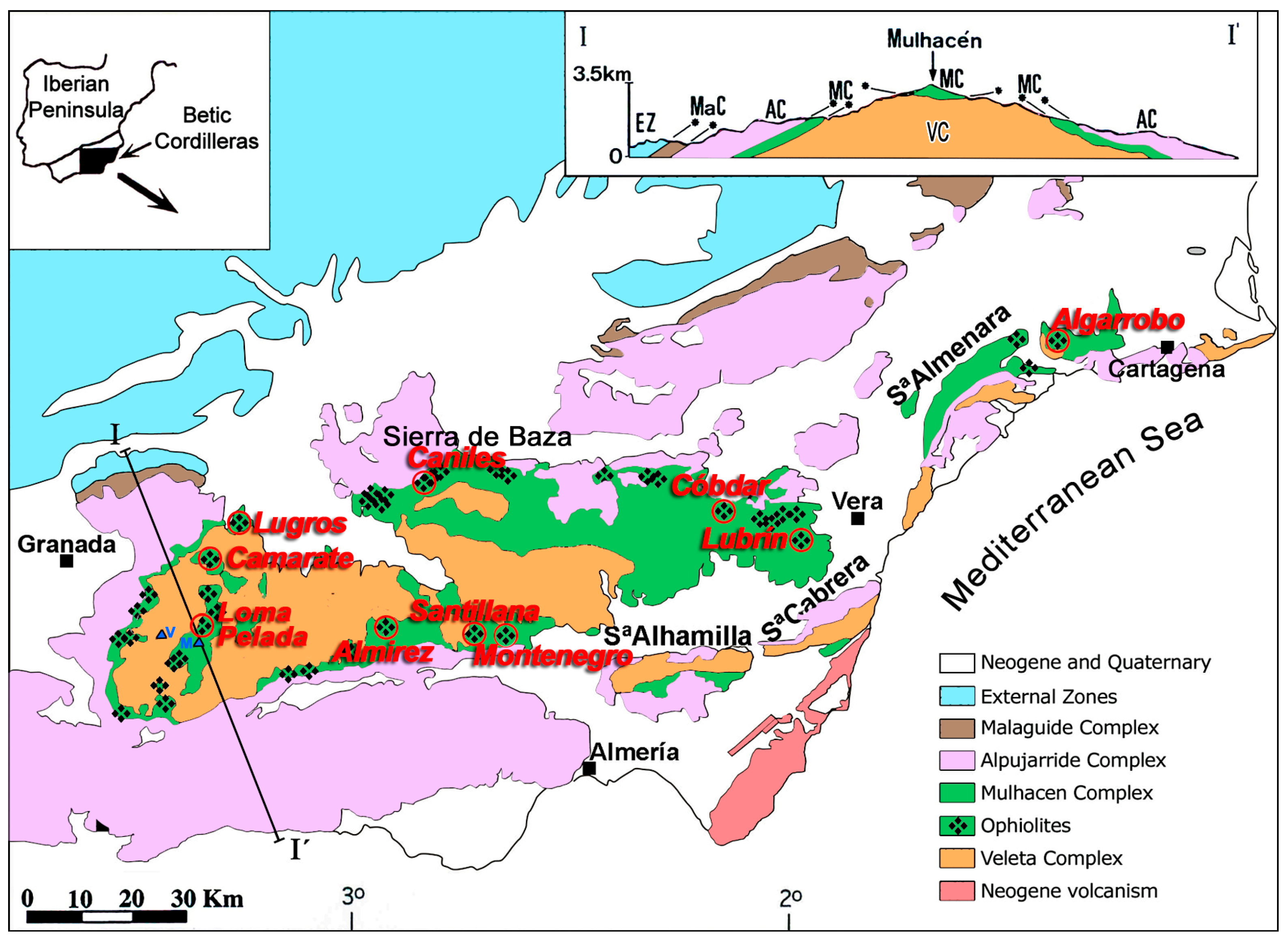
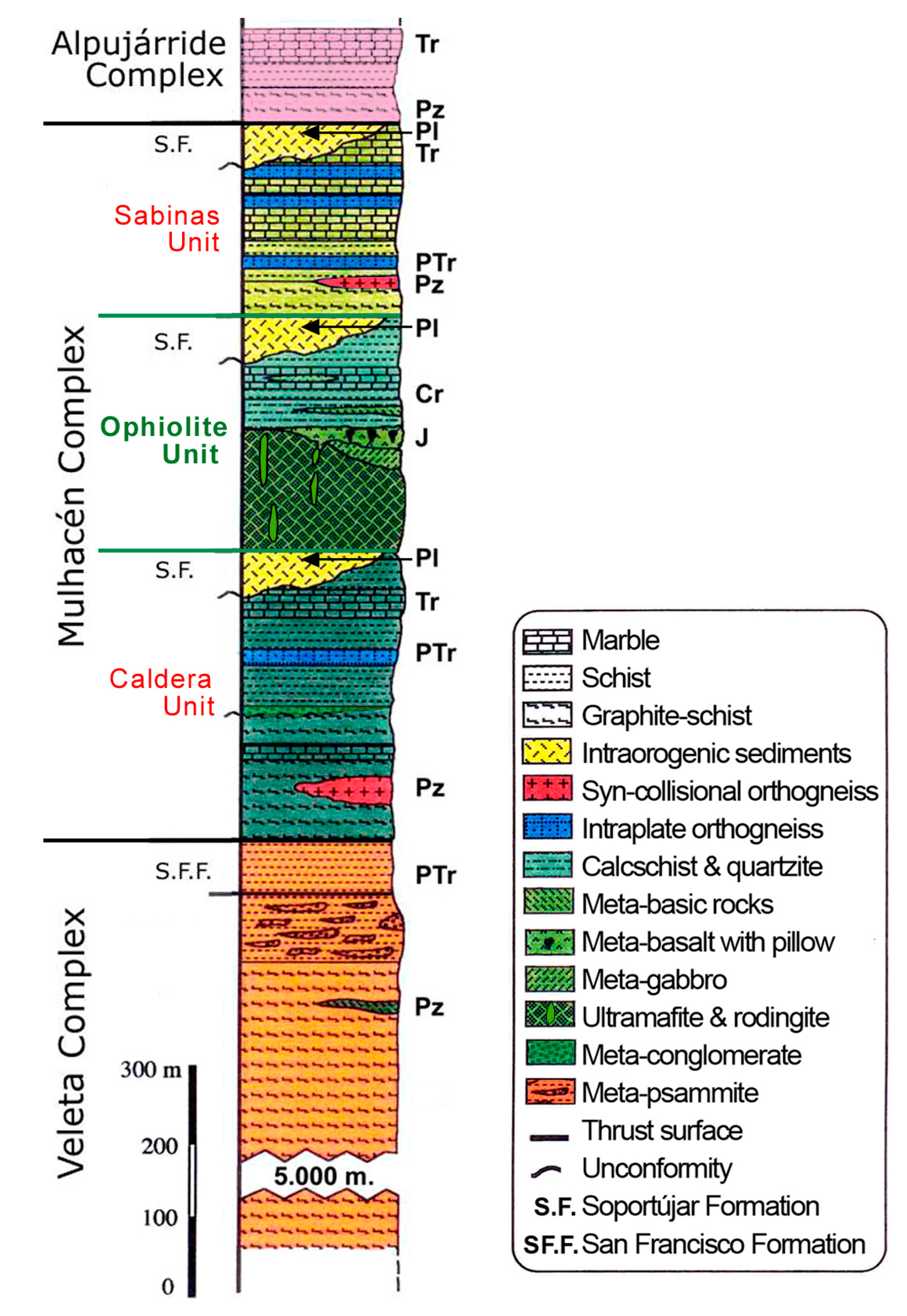
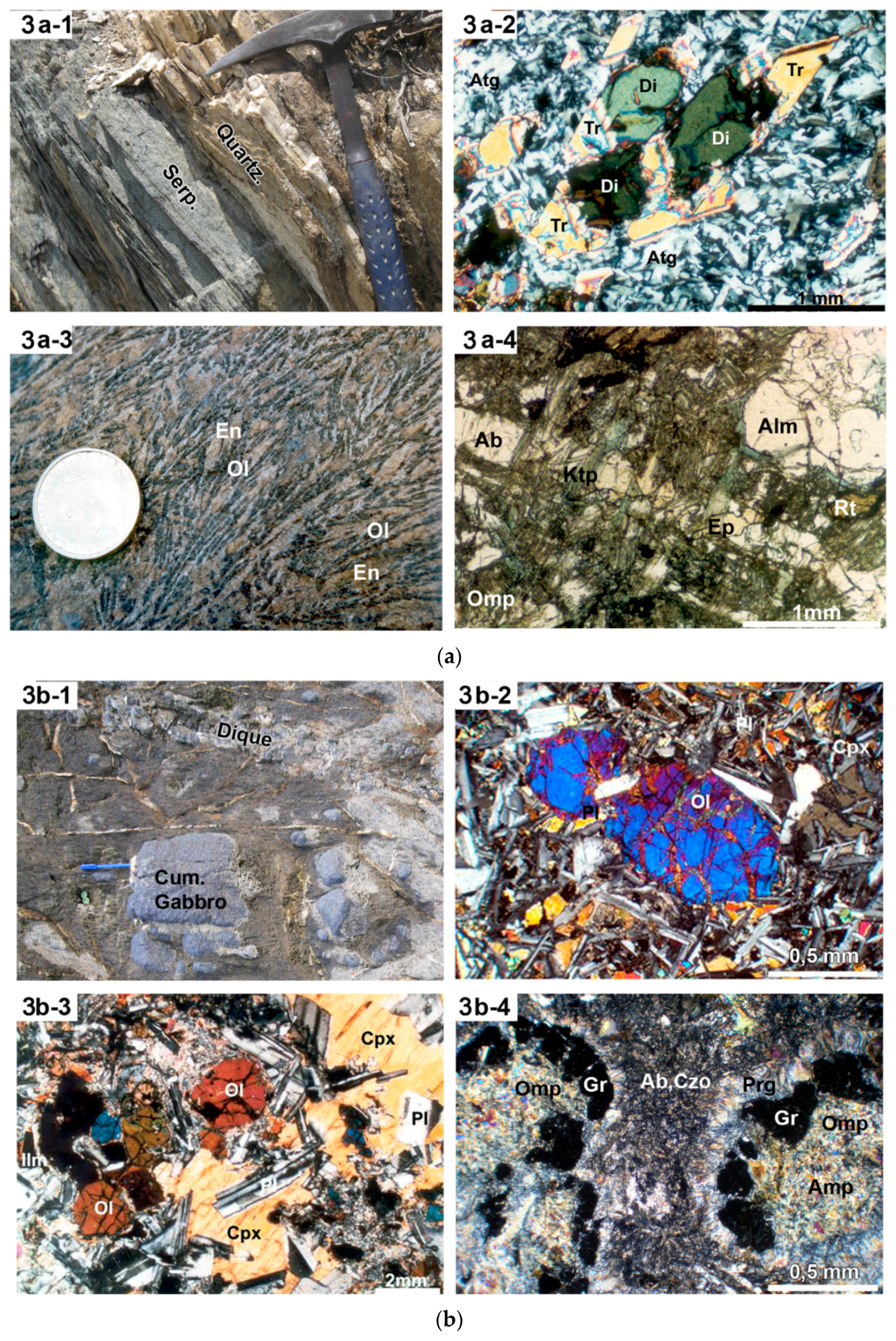
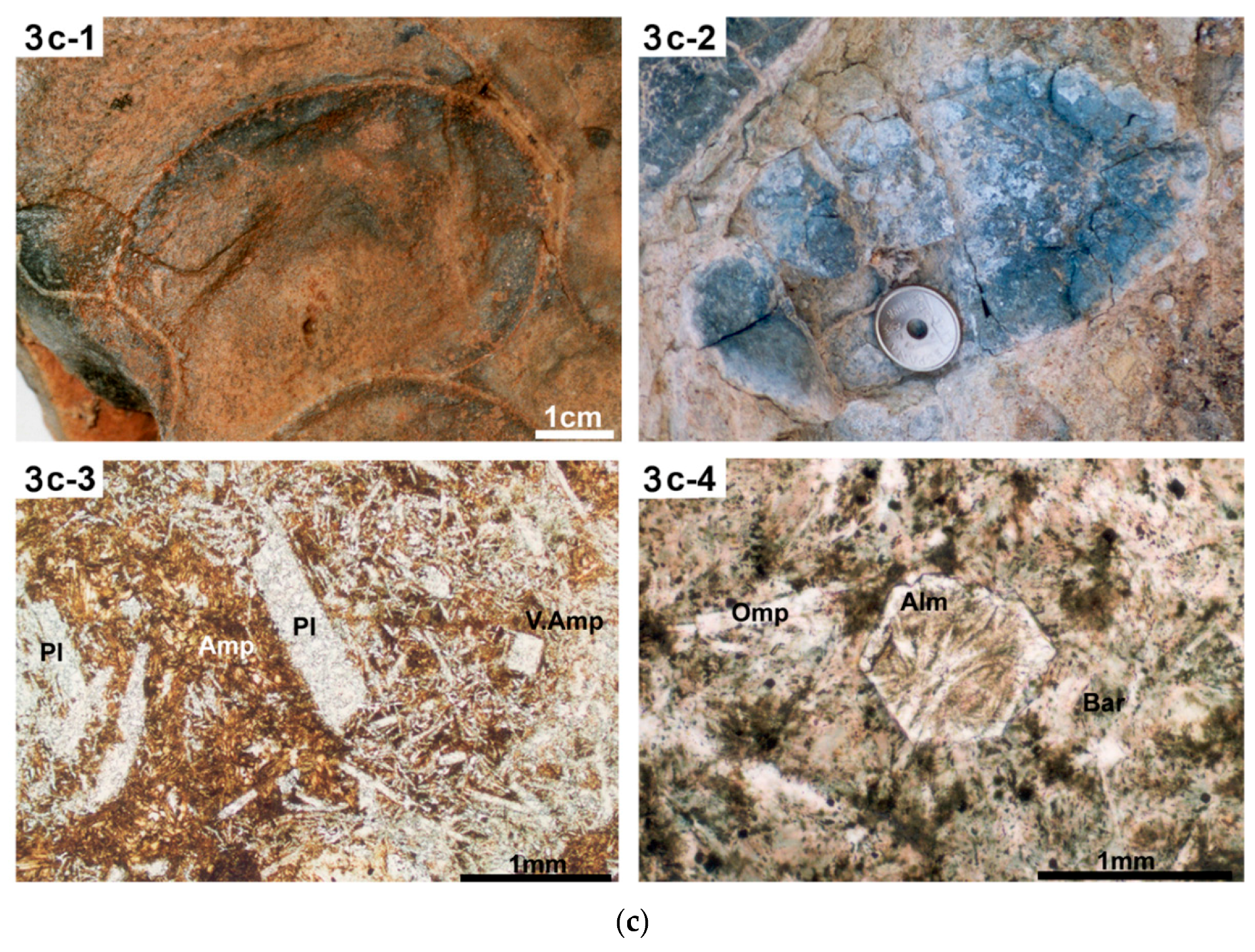
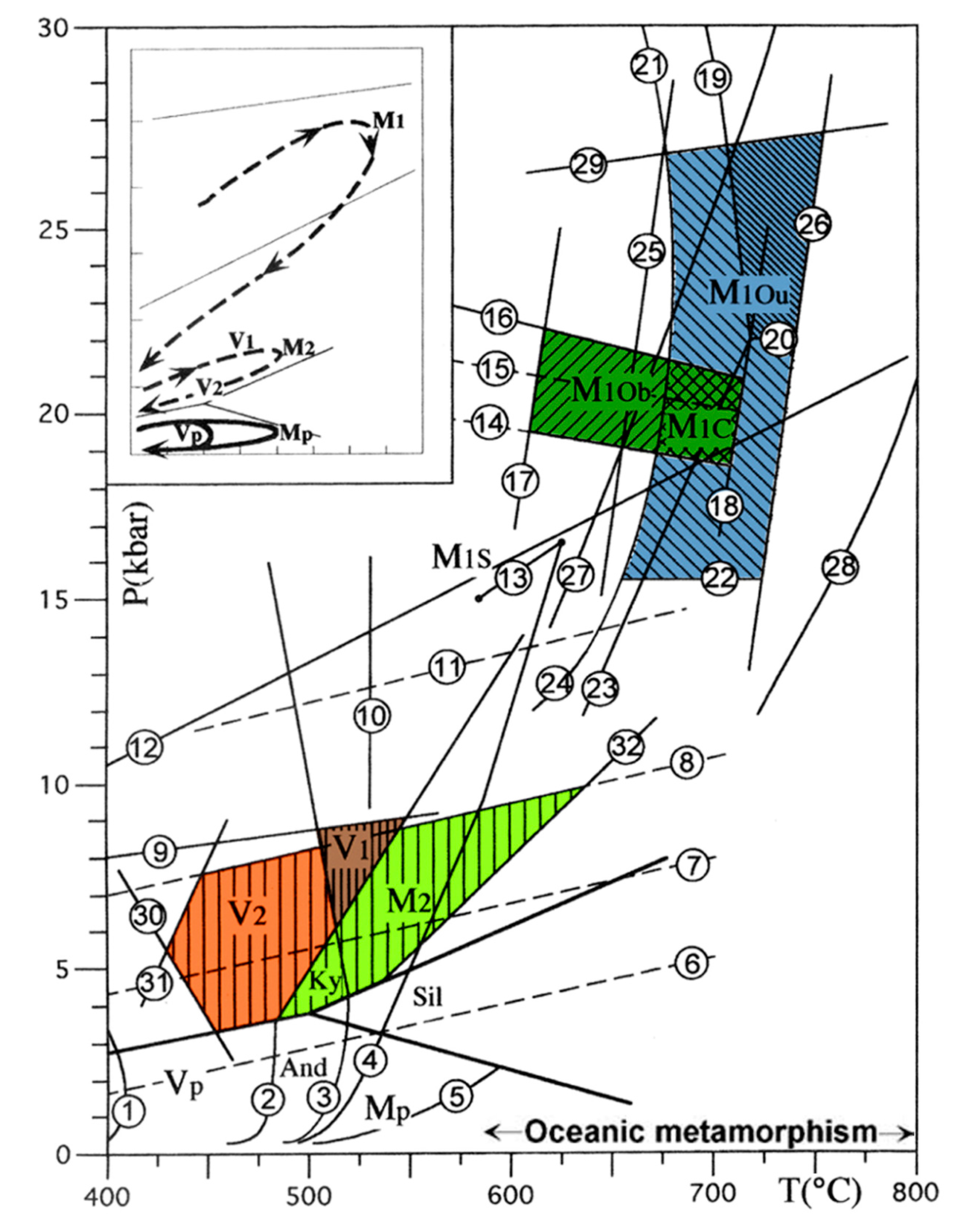
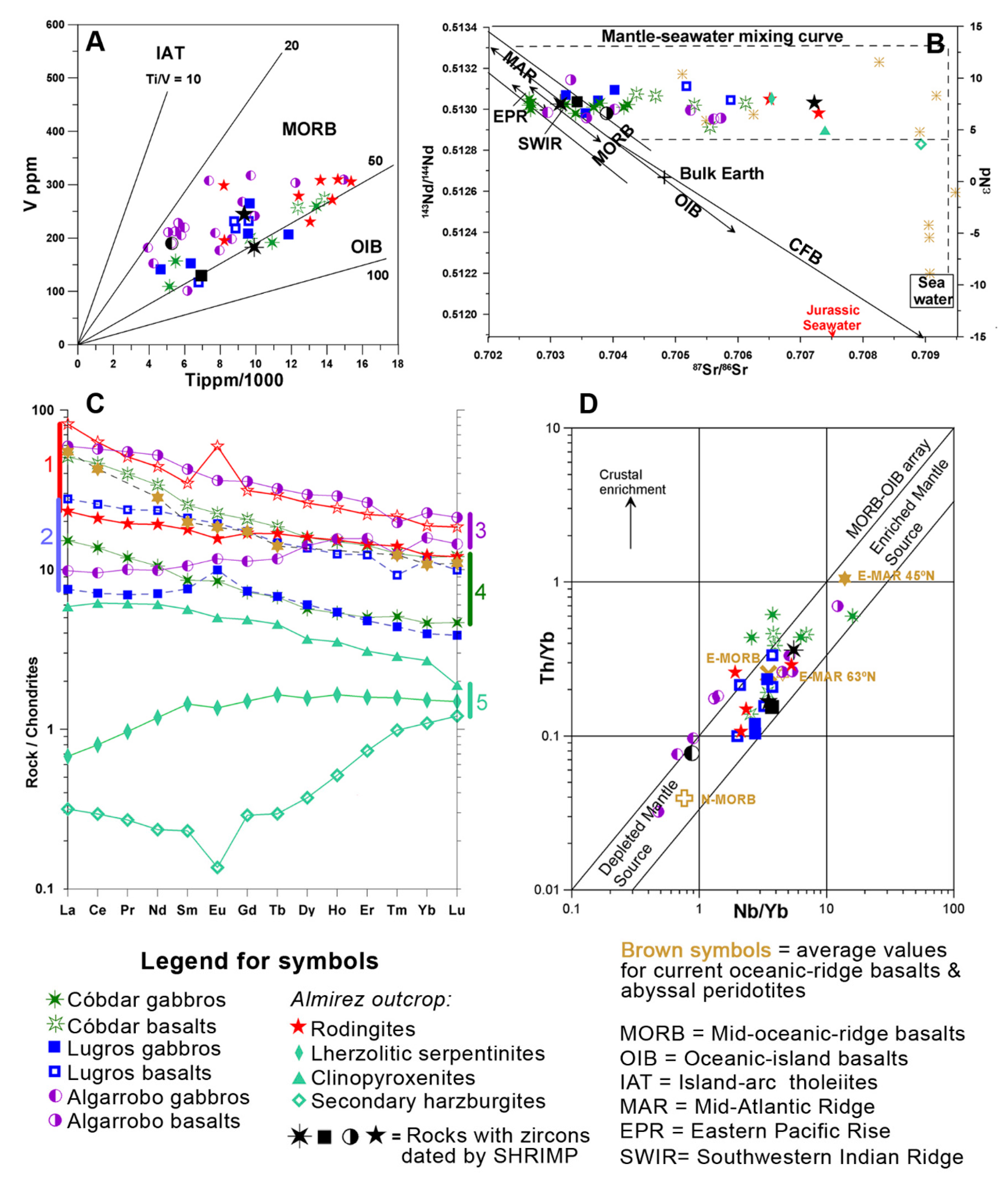

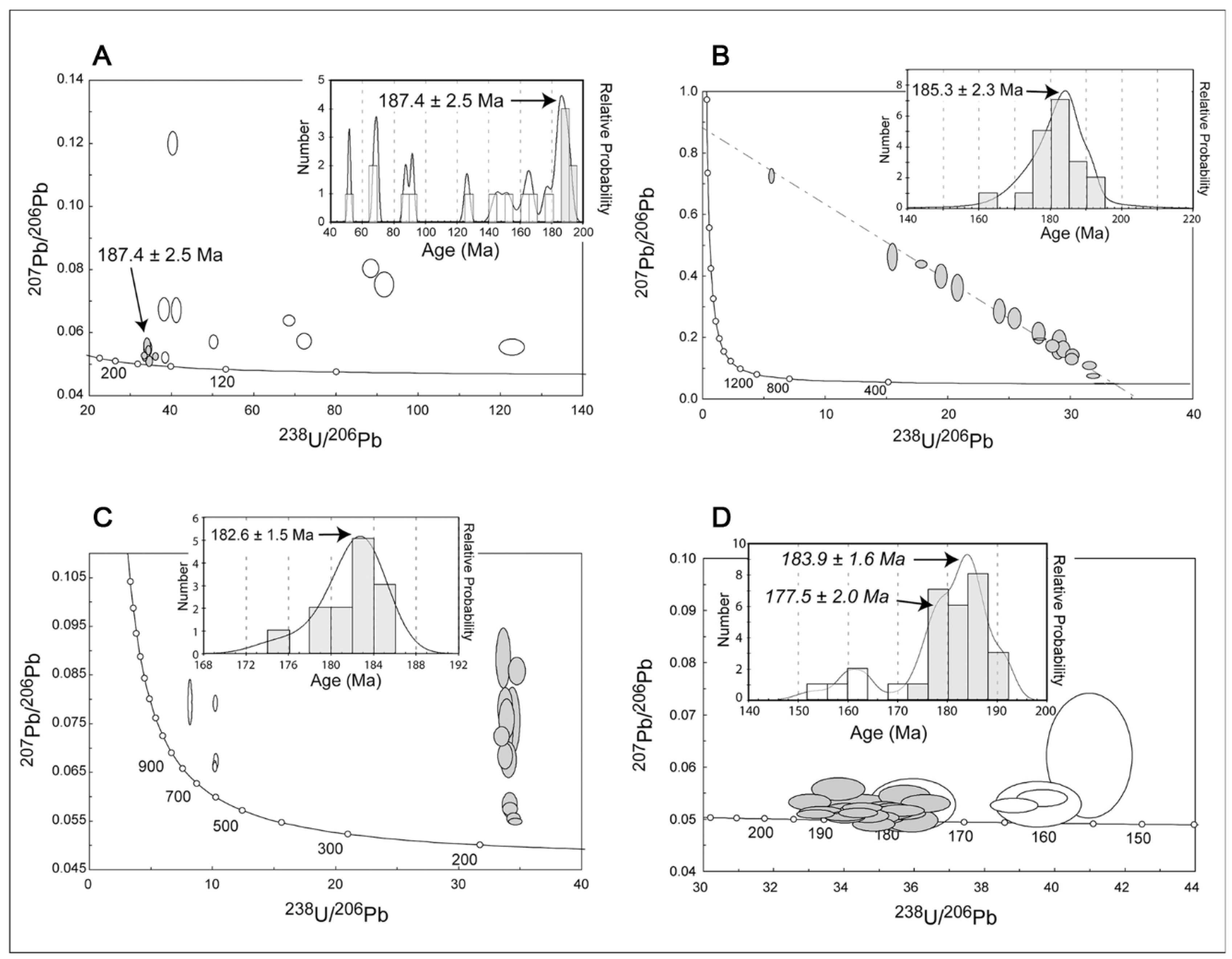
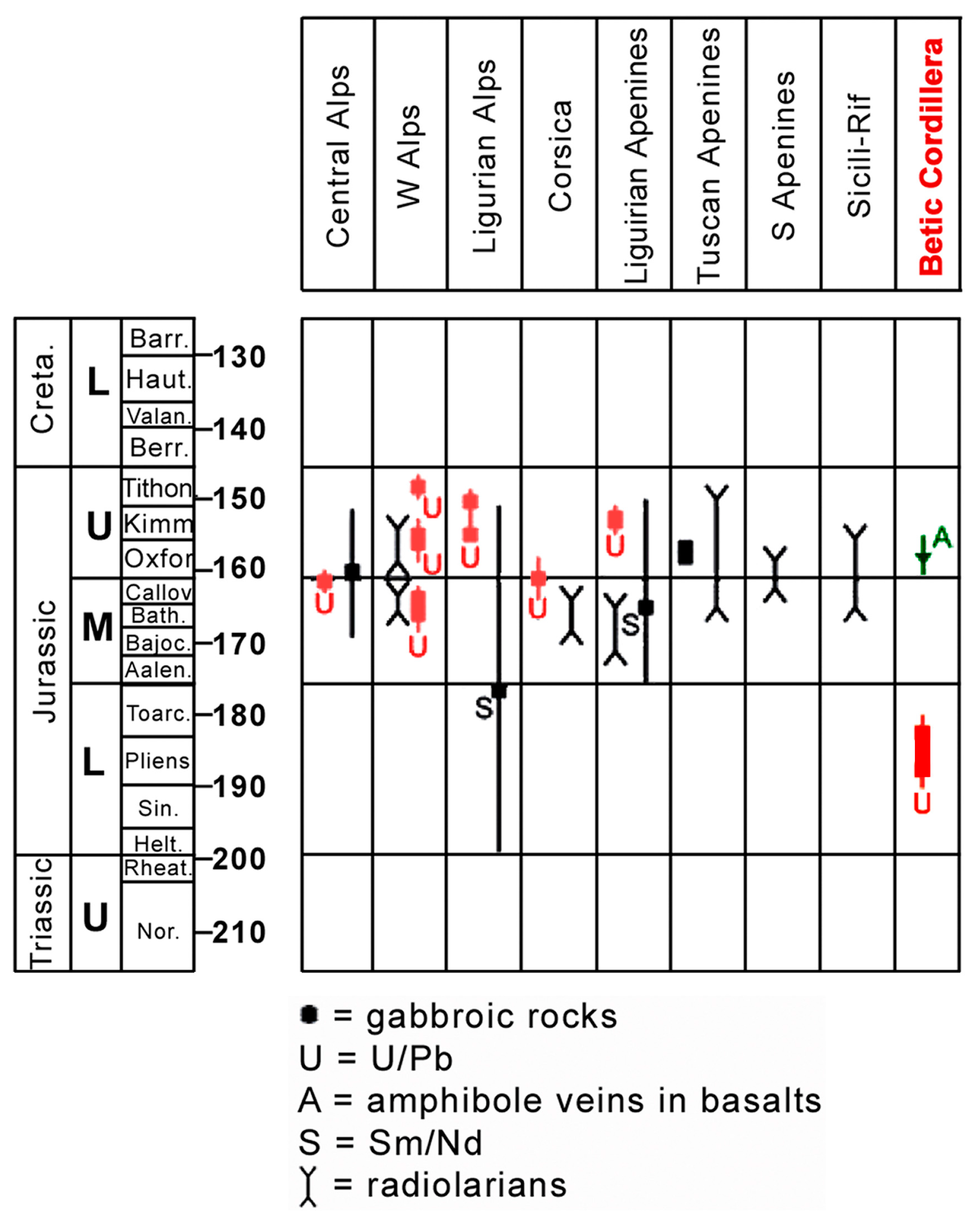
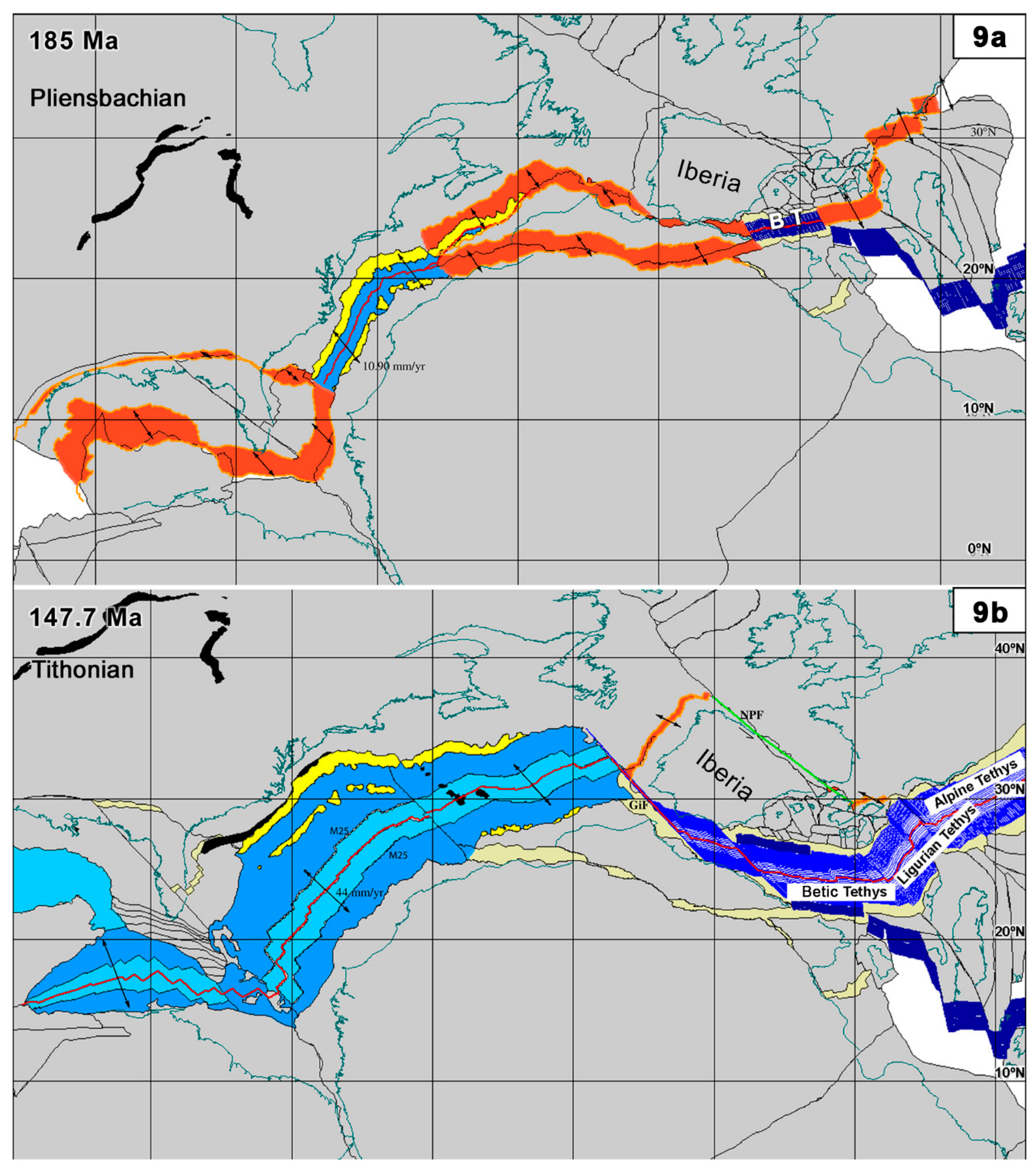
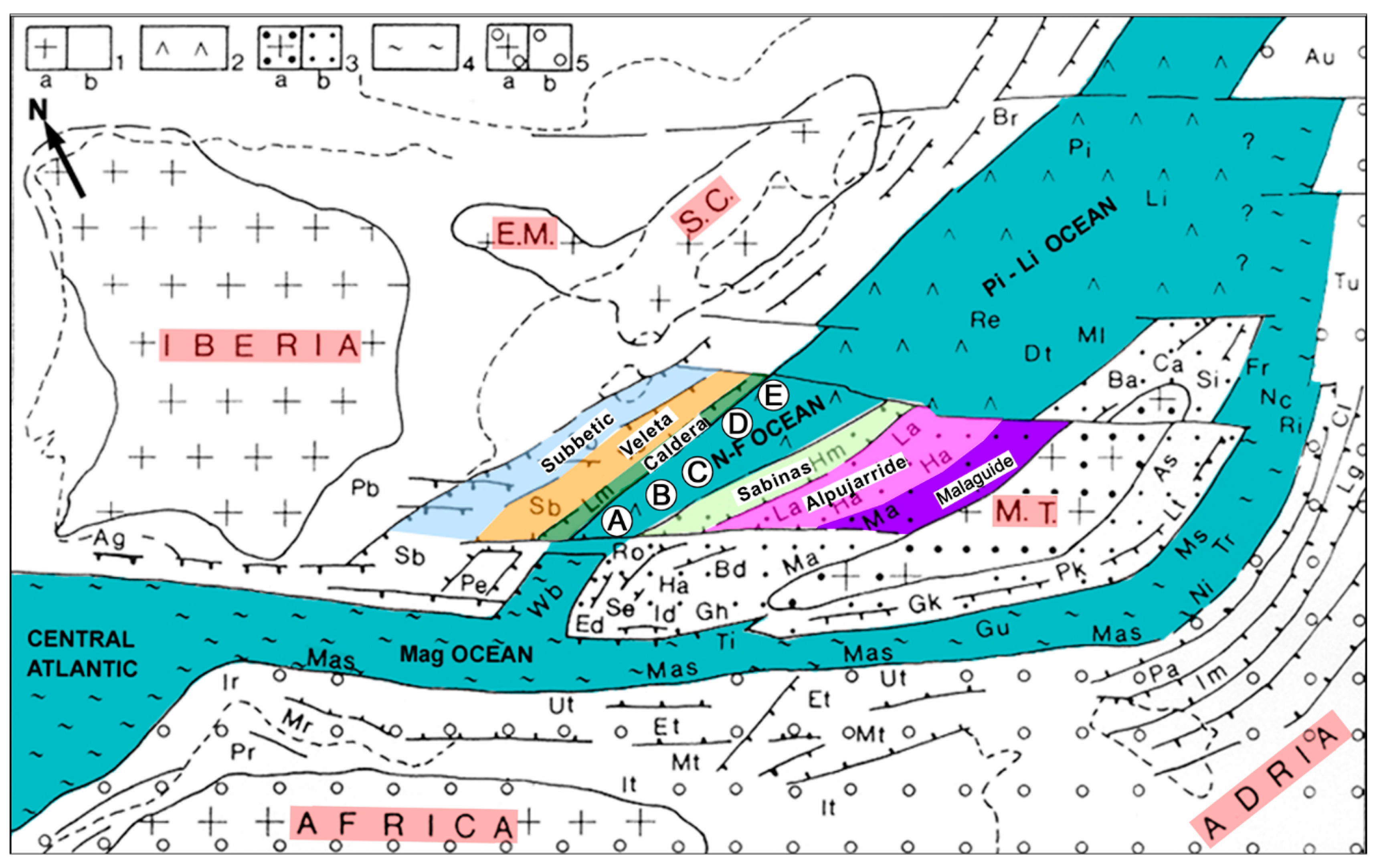

| Type of Sample | Locality | Method | Closing Age (Ma) | Reference |
|---|---|---|---|---|
| Jurassic magmatism | ||||
| Oscillatory zoned zircon in eclogitized gabbro | Lugros | SHRIMP U–Pb | 186.5 ± 2.5 | Puga et al. [15] |
| Oscillatory zoned zircon in eclogitized gabbro | Lugros | SHRIMP U–Pb | 187.4 ± 2.5 | Puga et al. [19] |
| Oscillatory zoned zircon in eclogitized rodingite | Almirez | SHRIMP U–Pb | 183.9 ± 1.6 | Puga et al. [19] |
| Oscillatory zoned zircon in eclogitized gabbro | Cóbdar | SHRIMP U–Pb | 185.3 ± 2.4 | This paper |
| Oscillatory zoned zircon in eclogitized gabbro | Algarrobo | SHRIMP U–Pb | 182.6 ± 1.4 | This paper |
| Biotite relic in gabbro | Lubrín | Ar/Ar | 173.2 ± 6.3 | De Jong [64] |
| Meta-Gabbro (WR) | Cóbdar | K/Ar | 174 ± 4 | Portugal Ferreira et al. [61] |
| Plagioclase igneous relict in dolerite | Cóbdar | K/Ar | 164 ± 4 | Portugal Ferreira et al. [61] |
| Olivine dolerite mineral isochrone | Lubrín | Rb/Sr | 146 ± 3 | Hebeda et al. [65] |
| Ocean-floor metamorphism | ||||
| Brown amphibole veins in metabasalt | Cóbdar | Ar/Ar laser | 158 ± 4.5 | Puga et al. [60] |
| Non-zoned recrystallized zircon areas in eclogite | Lugros | SHRIMP U–Pb | 152.4 ± 3.5 | Puga et al. [15] |
| Non-zoned recrystallized zircon areas in eclogite | Lugros | SHRIMP U–Pb | 155 ± 2.7 | Puga et al. [19] |
| Overgrowth rim on rodingite igneous zircon | Almirez | SHRIMP U–Pb | 177.5 ± 2 | Puga et al. [19] |
| Eo-Alpine event | ||||
| Phengite in amphibolite | Lubrín | Ar/Ar | 86.2 ± 2.4 | De Jong [64] |
| Glaucophane in amphibolite | Cóbdar | K/Ar | 72 ± 1 | Portugal Ferreira et al. [61] |
| Clouded whitish zircon areas in eclogite | Lugros | SHRIMP U–Pb | 80.4 ± 1.4 | Puga et al. [15] |
| Clouded whitish zircon areas in eclogite | Lugros | SHRIMP U–Pb | 73.5 ± 1.1 | Puga et al. [19] |
| Clouded whitish zircon areas in rodingite | Almirez | SHRIMP U–Pb | 59.2 ± 0.8 | Puga et al. [19] |
| Meso-Alpine event | ||||
| Barroisitic amphibole in retrograded eclogite | Sª Baza | Ar/Ar | 48.4 ± 2.2 | Monié et al. [62] |
| Barroisitic amphibole in retrograded eclogite | Cóbdar | Ar/Ar | 41.4 ± 2.3 | Puga et al. [13] |
| Clouded whitish zircon areas in eclogite | Lugros | SHRIMP U–Pb | 30.9 ± 0.6 | Puga et al. [15] |
| White mica in simplectitized amphibolite | Cauchiles | Ar/Ar | 28.5 ± 2.5 | Puga et al. [13] |
| Phengitic mica in amphibolite | Cóbdar | K/Ar | 27 ± 1 | Portugal Ferreira et al. [61] |
| Mg-hornblende in retrograded eclogite | Sª Baza | Ar/Ar | 24.6 ± 3.6 | Monié et al. [62] |
| Neo-Alpine event | ||||
| Metamorphic zircon in pyroxenite | Almirez | SHRIMP U–Pb | 15 ± 0.6 | Lopez Sánchez-Vizcaino et al. [63] |
| White mica in simplectitized amphibolite | Cauchiles | Ar/Ar | 13 ± 1.5 | Puga et al. [13] |
| Paragonite in amphibolite | Camarate | Ar/Ar | 12.4 ± 1.1 | Puga et al. [13] |
| Actinolite in amphibolitized rodingite | Almirez | K/Ar | 11 ± 3 | Portugal Ferreira et al. [61] |
| Actinolite in amphibolite | Camarate | Ar/Ar | 11 ± 0.9 | Puga et al. [13] |
© 2017 by the authors. Licensee MDPI, Basel, Switzerland. This article is an open access article distributed under the terms and conditions of the Creative Commons Attribution (CC BY) license (http://creativecommons.org/licenses/by/4.0/).
Share and Cite
Puga, E.; Díaz de Federico, A.; Fanning, M.; Nieto, J.M.; Rodríguez Martínez-Conde, J.Á.; Díaz Puga, M.Á.; Lozano, J.A.; Bianchini, G.; Natali, C.; Beccaluva, L. The Betic Ophiolites and the Mesozoic Evolution of the Western Tethys. Geosciences 2017, 7, 31. https://doi.org/10.3390/geosciences7020031
Puga E, Díaz de Federico A, Fanning M, Nieto JM, Rodríguez Martínez-Conde JÁ, Díaz Puga MÁ, Lozano JA, Bianchini G, Natali C, Beccaluva L. The Betic Ophiolites and the Mesozoic Evolution of the Western Tethys. Geosciences. 2017; 7(2):31. https://doi.org/10.3390/geosciences7020031
Chicago/Turabian StylePuga, Encarnación, Antonio Díaz de Federico, Mark Fanning, José Miguel Nieto, José Ángel Rodríguez Martínez-Conde, Miguel Ángel Díaz Puga, José Antonio Lozano, Gianluca Bianchini, Claudio Natali, and Luigi Beccaluva. 2017. "The Betic Ophiolites and the Mesozoic Evolution of the Western Tethys" Geosciences 7, no. 2: 31. https://doi.org/10.3390/geosciences7020031







